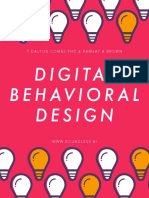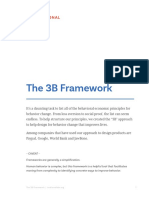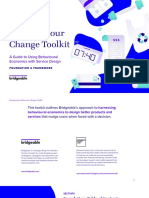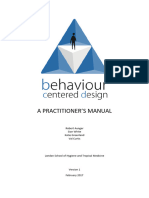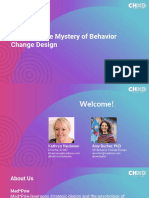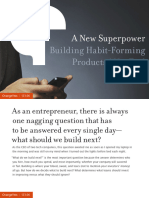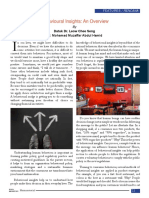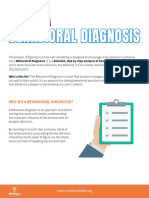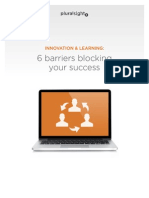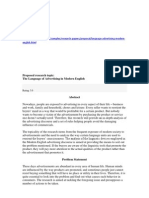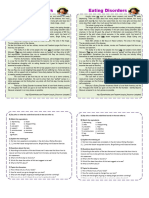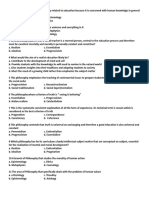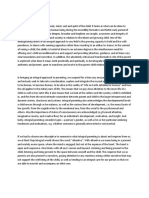D4BC SecondEdition Workbook Current
Uploaded by
Jose Hernando Cabrales LópezD4BC SecondEdition Workbook Current
Uploaded by
Jose Hernando Cabrales LópezA TOOLKIT ON
Designing For
Behavior Change
Stephen Wendel
June 2020
Practical materials to help you
apply techniques from the book,
Designing for Behavior Change
Introduction 1
Designing for Behavior Change at a Glance
Decisions and Behaviors 2
How we CREATE Action 3
DECIDE on Behavioral Interventions 5
Notes 6
Practical Exercises
Define the Problem: The Behavioral Project Brief 7
Define the Problem: A Hypothesis for Behavior Change 8
Explore the Context: The Behavioral Plan 9
Explore the Context: CREATE a Micro-Behavior 10
Explore the Context: Refine the Action and Action {Optional} 11
Craft the Intervention: Ways to Start an Action 14
Craft the Intervention: Ways to Stop an Action 15
Craft the Intervention: Evaluate Interventions with CREATE 16
Implement the Intervention: Design a Simple Email 17
Implement the Intervention: Ethical Checklist 18
Determine the Impact: Design the Experiment 20
Evaluate Next Steps: Visualize the Funnel 22
2 A Toolkit for Designing for Behavior Change
Introduction
You have a job to do. Perhaps you’re developing a brand-new product to help people to sleep better
or to learn a language. Or your boss has asked you to increase uptake or usage of your app. Or
maybe you just look around you and see something that doesn’t make sense—from people hurting
the environment, to failing to spend time with their families—and you want to make a difference.
There are traditional ways to do this: Scope out products that are
already out there to solve this problem; Ask your users what else
they are looking for.
The challenge is that these approaches are based on faulty
assumptions about people and how their minds work. Their
assumptions aren’t wrong, but they are incomplete. They assume
that people make careful plans and then thoughtfully execute them.
They assume people know what they’ll do in the future, and why
they’ll do it. Sometimes people do. But often, the reality of user
behavior is just much more complicated than that.
This toolkit will help you design products and communications that
change user behavior, to help your users do something they want to
do, but struggle with. It’s a companion to my book, Designing for
Behavior Change. The book offers a detailed look at why these
assumptions are wrong, how people really make decisions, and
what that means for product development. This guide extracts the
main practical exercises from the book, and puts them in one place:
to help you put those ideas into practice.
In particular, this guide is meant to help you design or refine a product, feature or communication.
It’ll help your users where they struggle to start or stop a key behavior: from exercising regularly, to
getting the most out of your product. It’s not about how to persuade them to do something; here, we
assume user interest, and build up from there.
In this toolkit, I’ve tried to create a short, simple presentation of main themes from the book, although
necessarily I had to drop some important details. These materials are drawn from worksheets I’ve
used with my own teams at Morningstar and HelloWallet.
If you’d like to learn more about this approach, please check out the full book on Amazon or Oreilly.com.
You can also reach out to me anytime at steve@behavioraltechnology.co. I’d love to hear about the
behavioral products you’re working on!
Stephen Wendel
A Toolkit for Designing for Behavior Change 1
2 Designing for Behavior Change at a Glance
Decisions and Behaviors
If we were to put decades of behavioral research into a few paragraphs (please forgive me, my fellow
researchers!), it would be these:
We’re limited beings: we have limited attention, time, willpower, etc. For example, there is a
nearly an infinite number of things that your users could be paying attention to at any moment. They
could be paying attention to the person who is trying to speak to them, the interesting conversation
someone else is having near them, or the report on their desktop that’s overdue, or the notification
on your app. Unfortunately, researchers have shown again and again that people’s conscious minds
can really only pay proper attention to one thing at a time.
Our minds use shortcuts to economize and make quick decisions, because of our limitations. Your
users have a myriad of shortcuts (aka heuristics), that help them sort through the range of options
they face on a day-to-day basis, and make rapid, reasonable decisions about what to do. For example,
if they don’t know what to do in a situation, they may look to what other people are doing and try to
do the same (a.k.a. descriptive norms). Similarly, habits are a powerful way in which people’s minds
economize and allow them to act quickly: by immediately triggering a behavior based on a cue.
Unfortunately, these shortcuts can go awry: with ingrained and self-destructive habits (over-
drinking) or heuristics that are applied in the wrong context (like herd behavior). Misapplied
heuristics are one cause of biases: negative tendencies in behavior or decision making (differing from
an objective standard of “good”). Often because of these biases, there’s a significant gap between
people’s intentions and their actions.
We’re of two minds: what we decide, and what we do, depends on both conscious thought and
nonconscious reactions like habits. This means that your users are often not “thinking” when they
act; or at least, they’re not choosing consciously. Most of their daily behavior is governed by
nonconscious reactions. Unfortunately, their conscious minds believe that they are in charge all the
time, even when they aren’t. We’re all “strangers to ourselves”: we don’t know the causes of our
own behavior and decisions. Thus your users’ self-reported comments about a problem in your
product or what they plan to do in the future aren’t necessarily accurate.
Decision and behavior are deeply affected by context, worsening or ameliorating our biases and
our intention-action gap. What your users do is shaped by our contextual environment in obvious
ways, like when the architecture of a site directs them to a central home page or to a dashboard. It’s
also shaped by non-obvious ways influences, like the people they talk and listen to (the social
environment), by what they see and interact with (their physical environment), and the habits and
responses they’ve learned over time (their mental environment).
We can cleverly and thoughtfully design a context to improve people’s decision-making and
lessen the intention-action gap. And that is the goal of Designing for Behavior Change and this toolkit.
2 A Toolkit for Designing for Behavior Change
Designing for Behavior Change at a Glance 2
How we CREATE Action
From moment to moment, why would you users undertake one action and not another? Six factors
must align, at the same time, before someone will take conscious action. Behavior change products
help people close the intention-action gap by influencing one or more of the following preconditions:
cue, reaction, evaluation, ability, timing, and experience. For ease of remembering them, they spell
CREATE: because that is what’s needed to create
action.
To illustrate these six factors, let’s say your user is
sitting on the couch, watching TV. Your app that
helps him plan and prepare healthy meals for his
family is on his phone; he downloaded last week.
When, and why, would he suddenly get up, find
his mobile phone, and start using the app?
We don’t often think about user behavior in this
way—we usually assume that somehow our
users find us, love what we’re doing, and come
back whenever they want to. But, researchers
have learned that there’s more to it than that,
because of the mind’s limitations and wiring. So,
again imagine your user is watching TV. What
needs to happen for him to use the meal planning
app right now?
1. Cue. The possibility of using the app needs to somehow cross his mind. Something needs to
cue him to think about it: maybe he’s hungry or he sees a commercial about healthy food on
TV.
2. Reaction. He’ll intuitively react to the idea of using the app in a fraction of a second. Is
using the app interesting? Are other people he knows using it? What other options come to
mind, and how does he feel about them?
3. Evaluation. He might briefly think about it consciously, evaluating the costs and benefits.
What will he get out of it? What value does the app provide to him? Is it worth the effort of
getting up and working through some meal plans?
4. Ability. He’ll check whether it’s actually feasible to use the app now. Does he know where
his mobile phone is? Does he have his username and password? If not, he’ll need to solve those
logistical problems first, and then use the app.
5. Timing. He’d gauge when he should take the action. Is it worth doing now, or after the TV
show is over? Is it urgent? Is there a better time? This may occur before or after checking for
the ability to act. Both have to happen though.
A Toolkit for Designing for Behavior Change 3
2 Designing for Behavior Change at a Glance
6. Experience. Even if logically using the app is worth the effort, and makes sense to use it
now, he’d be loath to try again if he’d tried the app before (or something like it) and it made
him feel inadequate or frustrated. Idiosyncratic personal experiences can overwhelm any
‘normal’ reaction a person might have.
These six mental processes are gates that can block or facilitate action. You can think of them as
“tests” that any action must pass: Your user must complete them successfully in order for him to
consciously, intentionally, engage in the target action. And, they all have to come together at the
same time. For example, if he doesn’t have the urgency to stop watching TV and act now, he could
certainly do it later. But when “later” comes, he’ll still face these six tests. He’ll reassess whether the
action is urgent at that point (or whether something else, like walking the dog, takes precedence). Or
maybe the cue to act will be gone and he’ll forget about the app altogether for a while.
So, products that encourage people to take a particular action have to somehow cue their users to
think about the action, avoid negative intuitive reactions to it, convince their conscious minds that
there’s value in the action, convince them to do it now, and ensure that they can actually take the
action. We can think about these factors as a funnel: at each step, people could drop off, get
distracted, or do something else. The most common outcome in behavior change work, and the one
we should expect, is the status quo. We seek to nudge that status quo into something new.
If someone already has a habit in place, and the challenge is merely to execute that habit, the process
is mercifully shorter. The first two steps (cue and reaction) are the most important ones, and, of
course, the action still needs to be feasible. Evaluation, timing and experience can play a role, but a
lesser one, because the conscious mind is on autopilot.
4 A Toolkit for Designing for Behavior Change
Designing for Behavior Change at a Glance 2
DECIDE on Behavioral Interventions
Behavioral science helps us understand how our environments profoundly shape our decisions and
our behavior. It shouldn’t come as a surprise that a technique that was tested in one setting (often in a
laboratory) doesn’t affect people in the same way in real life. To be effective at designing for behavior
change, we need more than an understanding of the mind: we need a process that helps us find the
right intervention and the right technique for a specific audience and situation.
What does this process look like? I like to think about it as six steps, which we can remember with the
acronym ‘DECIDE’: That’s how we decide on behavior-changing interventions in our products.
We start by defining the problem we’re trying to solve. Specifically, we
define the audience we’re working with and the outcome we’re trying to
Define the drive for them. Then as we explore the context, we’ll gather all the
Problem qualitative and quantitative data we can about the audience and their
environment, and see if we can reimagine the action to make it more
feasible and more palatable for the user even before we build anything.
From there, it’s time for crafting the intervention and implementing it in
Explore the
a product or communication. We’ll talk about how to design the decision-
Context
making environment—both the product itself and the surrounding
context that the person is in—to support action. We’ll also talk about how
to prepare users to take action with the product. We’ll use the process for
both the conceptual design (figuring out what the product should do) and
Craft the
Intervention the interface design (figuring out how the product should look).
Finally, we’ll test our new design in the field to determine its impact: did
it move the needle or did it flop? Based on that assessment, we’ll evaluate
what do to next. Is it good enough? Because nothing is perfect the first
Implement time, we’ll often need to iteratively refine it. This process also focuses on
the Solution three concepts: assessing the current impact on our users, developing
insights and ideas to further improve the product, and then iteratively
changing and measuring the product or communication until it’s served its
purpose (or other priorities intervene).
Determine
the Impact It’s important to emphasize that the process is inherently iterative. That’s
because human behavior is complicated, and this stuff is hard! If one could
simply wave a magic wand and other people would act differently, we
wouldn’t need a detailed process for designing for behavior change (and
that would be very disturbing). Instead, there’s an iterative process of
Evaluate Next
Steps learning about our users and their needs, and refining the product if it
misses the mark. The most overlooked, yet the most essential part of the
process isn’t great ideas and nifty behavioral science tricks: It’s careful
measurement of where our efforts go awry, and the wiliness and tools to
learn from those mistakes.
A Toolkit for Designing for Behavior Change 5
2 Notes
6 A Toolkit for Designing for Behavior Change
Practical Exercises: Define the Problem 3
In this section, you’ll find a series of exercises to use with your team to Design for Behavior Change: using DECIDE and
CREATE. You’ll also see examples of how to fill them out, based on an app that helps people exercise regularly.
The Behavioral Project Brief
Project: (E.g. Flash, the Exercise App) ________________________________________
New product, feature, or communication? Change to existing product, feature, or comm.?
VISION Briefly describe why you want to change behavior, and how this product fits in.
_________________________________________________________
_________________________________________________________
OUTCOME
What do you hope to achieve with the product? Consider both the company’s objective, as well as the
real-world measurable change that users will see and value. Then, drill down and define a rough metric
that your team can use to evaluate the product, and an idea of what success looks like, in numbers.
Company Objective Real-world Outcome
E.g. Increase revenue from B2B wellness clients. E.g. Less pain (back, neck, etc.)
Performance Metric Definition of Success
E.g. Doctor and Physical Therapy visits E.g. 50% decrease in Doctor/PT visits
A Toolkit for Designing for Behavior Change 7
3 Practical Exercises: Define the Problem
ACTOR
Who is the specific user (or other person involved in the product) who causes the outcome?
___________________________________________________
{E.g., sedentary white-collar workers}
______________________________________________________________________
USER
If product’s user isn’t the actor, describe the user and how they are supposed to influence the actor.
________________________________________________________________
{E.g., Same}
______________________________________________________________________
ACTION
What does the actor do/stop doing to accomplish the outcome? This an initial idea; we’ll refine it later.
_____________________________________________________
{E.g., Go to the gym twice a week}
______________________________________________________________________
A HYPOTHESIS FOR BEHAVIOR CHANGE
Alternatively, you can write out this information as an explicit hypothesis: to remind the team that,
nothing is for certain, and that you’ll need to test that hypothesis in practice through the product.
By helping {actor}____________________________________ [ ] start [ ] stop doing
{action} _________________________________________________________________,
we will accomplish {outcome}______________________________________________.
SPACE FOR MORE
As you continue the process of Designing for Behavior Change, you may want to update the project
brief with what you discover along the way: the Behavioral Diagnosis, your proposed intervention, etc.
There are worksheets for each of them, but it may be useful for you team to have that info in one place.
______________________________________________________________________
______________________________________________________________________
______________________________________________________________________
______________________________________________________________________
______________________________________________________________________
______________________________________________________________________
8 A Toolkit for Designing for Behavior Change
Practical Exercises: Explore the Context 3
The Behavioral Plan
On the left side of this page, describe each small micro-behavior the user needs to take to move from inaction to
action. Then, on the right, ask whether the six CREATE preconditions for action are in place at each step. Check
existing preconditions off of the list and describe briefly, for reference. Where one is missing, think about how you can
START restructure the action, change the environment, or educate the user to help move him or her through the process.
WHAT IS THE USER’S INITIAL STATE?
E.g. Sedentary, does not normally exercise
WHAT DOES THE USER DO FIRST?
E.g. Opens email inviting him or her to download the app
WHAT DOES THE USER DO NEXT?
E.g. Installs app using employee ID and unique password
WHAT DOES THE USER DO NEXT?
E.g. Enters information into app to inform personalized recommendations
FINI
USER TAKES ACTION!
E.g. Goes to a class at the gym!
A Toolkit for Designing for Behavior Change 9
Ffff
3 Practical Exercises: Explore the Context
CREATE a Micro-behavior
Select one of the micro-behaviors in your behavioral plan that appears to be a problem – from talking with
users or from the data you’ve gathered. Analyze the CREATE factors for that specific micro-behavior.
When you seek to start a behavior, missing CREATE factor(s) are obstacles. When seeking to stop
a behavior, just document it for now: each factor can be changed to become an obstacle.
Condition Current Status? Obstacle? (Y or N)
Cue to think about
taking action
E.g. Relevance of email is unclear. E.g. Yes
Emotional
Reaction E.g. Aiming for positive. E.g. No
Conscious
Evaluation of costs
and benefits
E.g. Long, multi-step sign-up process. E.g. Yes
Ability to act
(resources, logistics,
self-efficacy) E.g. Ensure all users feel capable E.g. No
Timing and urgency
to act
E.g. No urgency or commitment E.g. Yes
Prior Experience
taking action
E.g. Varied E.g. Not sure
The Behavioral Diagnosis
Look over your behavioral plan, and CREATE analysis. Steps with major obstacles are where you’ll devote
your attention for the next stage in DECIDE: crafting interventions. The obstacles form a behavioral diagnosis.
We believe that {Actor}____________________________ does not [ ] start [ ] stop doing
{action} ____________________________________, because when it comes time to
{micro-behavior} ________________________________________________________,
{CREATE obstacle} ______________________________________________________.
10 A Toolkit for Designing for Behavior Change
Practical Exercises: Explore the Context 3
Refine the Actor and Action {Optional}
For some products, especially existing ones, the actor and action are obvious and not in doubt. In that
case, skip this exercise. However, as you explore the context you may learn more about your users and
their situation, and realize that your initial assumptions were incorrect. If you think the product might
appeal to or help another group, or that your team is offering the same tired solutions that haven’t
worked in the past, this worksheet can help you revisit and refine them.
ACTION
Brainstorm four very different actions that people can take to achieve your target outcome because
of your product or communication. When thinking through possible actions, keep these
points in mind:
• The obstacles people currently face to achieving the outcome
• What needs to happen right before the outcome
• How your company is uniquely positioned to help people achieve the outcome
• What people who currently achieve the action are doing
Action 1 Action 2
E.g. Solo run 2x per week, starting with 2 miles E.g. Write down exercise goals
Action 3 Action 4
E.g. Get a personal trainer at the gym E.g. Participate in an in-person workplace fitness program
A Toolkit for Designing for Behavior Change 11
3
Ffff
Practical Exercises: Explore the Context
ACTORS
Create descriptions of the specific people who will take action because of your product. Usually, the
actor is your user – but not always. For example, with B2B products, the person who first engages with
your company may be a corporate buyer, who gives access to the product to users within the company.
For the sake of simplicity though, we’ll refer to the actor as the user here.
Does this user ...
12 A Toolkit for Designing for Behavior Change
Practical Exercises: Explore the Context 3
Now, think of a group that is VERY different from the obvious persona.
EVALUATE
Now that you’ve come up with four different actions people can take to achieve the targeted outcome,
evaluate each according to how well it meets the needs of your company and users. Ideally, you’d do this for
each of the 3 personas listed above. To start, though, pick one.
For each action place a scale of 1 through 5 the degree you agree or disagree with the following:
Impact: Taking the action will directly lead to the targeted outcome among the user base.
Ease: Taking the action will not require a lot of resources from users (time, money, etc.)
Cost: Building the new product is a cost-effective use of your company’s resources.
Fit: Supporting the action makes sense for your company’s larger goals and culture.
Score each action across each of the criteria using the table below. Compare total and individual scores to
select the action your team should target. Even though we have attached numbers, there is no hard-and-
fast rule here: your final decision will depend on the priorities and constraints of your company.
1 - Strongly Disagree 2 - Disagree 3 - Neutral 4 - Agree 5 - Strongly Agree
Action 1 Action 2 Action 3 Action 4
Name E.g. Run 2 miles solo 2x/week. E.g. Write down exercise goals. E.g. Get a personal trainer at the gym. E.g. Participate in workplace program.
Impact
Ease
Cost
Fit
Total
If you’ve decided on a new target actor or action, update the behavioral brief, and re-do your behavioral plan.
A Toolkit for Designing for Behavior Change 13
3
Ffff
Practical Exercises: Craft the Intervention
Craft the Intervention: Ways to Start an Action
For your reference, and to spur ideas for interventions, here are the main techniques described in
Designing for Behavior Change to help your users start taking a conscious action. They are
organized by the primary behavioral obstacle (CREATE) that they help your user overcome.
Component To Do This Try This
Cue Create a cue Tell the user what the action is
Create a cue Relabel a cue
Create a cue Use reminders
Increase power of cue Make it clear where to act
Increase power of cue Remove distractions
Target a cue Go where the attention is
Target a cue Align with people’s time
Reaction Elicit positive feeling Narrate the past
Elicit positive feeling Associate with the positive
Increase social motivation Deploy social proof
Increase social motivation Use peer comparisons
Increase trust Display strong authority
Increase trust Be authentic and personal
Increase trust Make it professional & beautiful
Evaluation Economics 101 Make sure the incentives are right
Highlight and support existing motivations Leverage existing motivations
Highlight and support existing motivations Avoid direct payments
Highlight and support existing motivations Test out different types of motivators
Increase motivation Leverage loss aversion
Increase motivation Use Commitment Contracts
Increase motivation Pull future motivations into the present
Increase motivation Use competition
Support conscious decision making Make sure it’s understandable
Support conscious decision making Avoid cognitive overhead
Support conscious decision making Avoid choice overload
Ability Remove Friction Remove unnecessary decision points
Remove Friction Default everything
Remove Friction Elicit implementation intentions
Increase sense of feasibility (self-efficacy) Deploy (positive) peer comparisons
Increase sense of feasibility (self-efficacy) Help them know they’ll succeed
Remove physical barriers Look for physical barriers
Timing Increase urgency Frame text to avoid temporal myopia
Increase urgency Remind of prior commitment to act
Increase urgency Make commitments to friends
Increase urgency Make a reward scarce
14 A Toolkit for Designing for Behavior Change
Practical Exercises: Craft the Intervention 3
Experience Break free of the past Use Fresh Starts
Break free of the past Use Story Editing
Break free of the past Use Slow-down techniques
Avoid the past Make it intentionally unfamiliar
Keep up with changing experiences Check back in with users
Ways to Stop an Action
Similarly, here are the main techniques described in Designing for Behavior Change to help your
users stop an unwanted action. They are organized by the type of behavioral obstacle that they create.
Component To Start To Stop
Cue Relabel something as a cue Unlink the action from other behaviors that flow into
it
Use reminders Remove reminders
Make it clear where to act Make the cue more difficult to see or notice
Remove distractions Add distractions and more interesting actions
Align with people’s time Move the cue to a time the person is busy, or make the
person busy at the existing time
Reaction Narrate the past Narrate the past to highlight prior successes at
resisting the action
Associate with the positive Associate with action with negative things the person
doesn’t like
Deploy social proof Deploy social disproof (show that other people shun
it) and social support for change (AA meetings)
Use peer comparisons Use negative peer comparisons (show that most other
people resist it, don’t do it)
Be authentic and personal Be authentic and personal in your appeal to stop
Make it professional & beautiful Make the surroundings ugly or unprofessional
Evaluation Make sure the incentives are right Increase the costs, decrease the benefits
Leverage existing motivations Unlink the action from existing motivations
Test out different types of motivators Test out different types of motivators to stop (don’t
assume ‘because it’s good for you’ will work)
Leverage loss aversion Leverage loss aversion (same!)
Use Commitment Contracts Use Commitment Contracts (same!)
Pull future motivations into the present Increase motivation
Use competition Use competition to stop (e.g. Quit competitions, AA
chips, Biggest Loser)
Avoid cognitive overhead Add to cognitive overhead
Avoid choice overload Add to choice overload
A Toolkit for Designing for Behavior Change 15
3
Ffff
Practical Exercises: Craft the Intervention
Ability Remove unnecessary decision points Add small pauses and frictions
Default everything Require choices, remove defaults
Elicit implementation intentions Elicit implementation intentions (on how to avoid
temping situations)
Deploy (positive) peer comparisons Deploy positive peer comparisons – examples of other
succeeding at stopping (same!)
Help them know they’ll succeed Help them know they’ll succeed (same!)
Look for physical barriers Add physical barriers (no keys to the car, etc.)
Timing Frame text to avoid temporal myopia Frame text to avoid temporal myopia (same – for the
benefits of stopping)
Remind of prior commitment to act Remind of prior commitment to act (same, for a
commitment to stop)
Make commitments to friends Make commitments to friends (same, to stop)
Experience Use Fresh Starts Use Fresh Starts
Use Story Editing Use Story Editing
Use Slow-down techniques Use Slow-down techniques
Evaluate Multiple Interventions with CREATE
When your team is evaluating alternative interventions for a particular micro-behavior or step on the
behavioral plan, you can quickly assess the strengths and weaknesses (from a behavioral perspective)
of each using a checklist like this:
Condition Current With With
State Intervention # 1 Intervention #2
E.g. Current state w/r to E.g. Invitation email that touts the E.g. Invitation email that employs
installing the Flash app benefits of the app social proof
Cue to think about taking action
Emotional Reaction
Conscious Evaluation of costs and benefits
Ability to act (resources, logistics, self-efficacy)
Timing and urgency to act
Prior Experience taking action
16 A Toolkit for Designing for Behavior Change
Design a Simple Email Announcing Your Product
Here, we’ll design a simple email about the product, building on the behavioral questions you’d ask when
working on the full architecture and layout of the product itself. Take a look at your behavioral plan
— what are the riskiest or more difficult pieces? Use the table on page 14 to select specific techniques to
employ in this email (like scarcity, social proof, etc.) to help users overcome those obstacles.
Start the New Year off Right! 1 1. Subject Line:
3 Start the New Year off Right! 2. Send Day & Time:
3. Short Description:
4. Link Text:
5. Image:
6. Detailed Description:
6 This year, give yourself the most valuable gift of all – a healthy mind and
body. The Flash app can help you do just that. Our certified trainers will
work with you to streamline your routine so reaching your wellness goals is
easier than ever. Not only will you increase your strength and flexibility, but
a healthier you can add another year or more to your life.
Flash is available through your employer, for free! When you join, you’ll
have unlimited access to all of our classes at your local gym, so you can
create a schedule that fits into your life.
To get the Flash App today, visit www.flashapp.com to learn more about
the program, and identify appropriate classes and trainers at your local
gym. You can also call 1-800-123-4567 to speak with our team.
Flash recommends consulting your doctor before starting any new
exercise program. If you have any questions, contact one of our staff
members at trainers@flashapp.com
Ok, that’s a good start. Now, what about this email do you want to test?
ELEMENT TO CHANGE NEW VERSION TO TEST
A Toolkit for Designing for Behavior Change 17
3 Practical Exercises: Implement the Intervention
Implement the Intervention: Ethical Checklist
If your organization has an Institutional Review Board (IRB), or has a process modeled on the IRB, then you
should use the templates and processes from that review board. If you don’t have an IRB, here is a worksheet to
get you started, modeled on tools we’ve starting using on my team. Some fields can be copied directly from the
project brief, or the project brief can be attached for reference.
Practitioner: _______________________ Project: ____________________________ Date: _____________
DESCRIPTION AND PURPOSE
1. Please describe the product, feature, or communication (henceforth: “product”) to be developed.
____________________________________________________________________________
2. What specific behavior (action) does the project seek to change, and does it support or hinder it?
____________________________________________________________________________
3. What behavioral intervention(s) does the product use to support that change?
____________________________________________________________________________
4. Who is the target population (actor)?
____________________________________________________________________________
5. How, if at all, will this benefit that population (user outcome)?
____________________________________________________________________________
6. In what ways might this intervention cause notable harm to the individual, in the short term, or in
the long term (e.g., products that seek to addict their users to its use)
____________________________________________________________________________
7. How will this benefit your organization or team?
____________________________________________________________________________
8. What financial or personal interest do you have in this project succeeding?
___________________________________________________________________________
TRANSPARENCY AND FREEDOM OF CHOICE
1. Does the target audience want to accomplish the outcome? Do they want to change the behavior?
____________________________________________________________________________
2. Does the target audience know that you are seeking to change their behavior? And, if not, will
they be upset when they become aware of it?
____________________________________________________________________________
18 A Toolkit for Designing for Behavior Change
Practical Exercises: Implement the Intervention 3
3. Is the user defaulted-out, defaulted-in, or is it a condition of use for the product to interact with
these interventions? Can the user opt-out in a straightforward and transparent manner?
____________________________________________________________________________
4. What steps will be taken to minimize the possibility of coercion?
____________________________________________________________________________
DATA HANDLING AND PRIVACY
If data privacy issues are not already addressed elsewhere in the company’s standard product development
process, this is a good place to cover those issues. If they are covered, skip these.
1. What personal information does this product gather?
____________________________________________________________________________
2. How are those data handled to ensure privacy of the users?
____________________________________________________________________________
FINAL REVIEW
This project been independently reviewed and approved by
___________________________________________________ {name of review body for the company}
on ____________________________________________ ____{date}.
A Toolkit for Designing for Behavior Change 19
3 Practical Exercises: Determine the Impact
Design the Experiment
Experiments (e.g., A/B Tests) are often the best way to assess whether your product is having the
desired effect. This worksheet will walk you through the process of designing one.
STEP 1: WHAT’S BEING TESTED?
Control: Do Nothing Existing Version
E.g. Do Nothing (Control group not sent an email reminder.)
Variation 1:
E.g. Email reminder, inviting people to sign up for the Flash app, focused on creating peer comparisons and competition.
Variation 2 (if any):
E.g. Email reminder, inviting people to sign up for the Flash app, focused on reaching individual goals, investing in yourself.
What’s the outcome metric?
E.g. Number of signups for the app (short-term outcome of the email campaign); Decreased physical therapy visits (long-term outcome of the app) .
Is it measured the same way for both versions? Yes [Continue to Step 2] No/Not Sure [Stop!]
STEP 2: WHAT ARE THE EXTREME OUTCOMES?
What’s the baseline value? (What should the control group have?)
BASELINE:
E.g. 35% of target population (employees of wellness client companies) are currently signed up for the Flash app, based on existing outreach efforts.
What’s the Minimum Meaningful Effect (MME)?
(I.e. the smallest change in the outcome that means you’ve been successful) No idea? Enter the smallest delta seen before.
MME:
E.g. 2.5% increase in enrollment among the target population.
What’s the Largest Viable Effect (LVE)?
(I.e. the largest change in the outcome that you’d expect to have) No idea? Enter 2x the largest delta seen before.
LVE:
E.g. 10% increase in enrollment through the new email campaign.
20 A Toolkit for Designing for Behavior Change
STEP 3: CALCULATE SAMPLE SIZE AT THE EXTREMES
For the MME and LVE:
IF THE OUTCOME IS A
PERCENTAGE (CLICKS, SIGNUPS) AVERAGE (AUM)
You’ll get a sample size
Use a power calculation tool for Use a power calculation tool for
proportions. You’ll need the Baseline continuous values. You’ll need the for each one: the MME
Percentage and Effect Baseline Value, Baseline Standard Size and LVE Size.
Size (MME, LVE) Deviation, and Effect
Size (MME, LVE)
* See BehavioralTechnology.co for links to sample tools. Use 0.9 for “power” and .95 for “alpha”
STEP 4: HOW MANY PEOPLE COULD YOU INCLUDE IN THE TEST?
Do you have a fixed list of people?
Yes (Use the list size.) No, I have a stream of people over time (What’s your timeline? Calculate how many people you’d see by then.)
NUMBER OF PEOPLE AVAILABLE:
STEP 5: HOW MANY PEOPLE SHOULD BE IN EACH GROUP?
Divide the number of people you have (step 4) by the number of variations (step 1) to calculate the number of
people (sample size) per version. NUMBER OF PEOPLE PER VERSION:
STEP 6: DO YOU HAVE WHAT YOU NEED?
SAMPLE SIZE DECISION NEXT STEPS
Stop! • Move on to other tests
Don’t bother running the test, it can’t
tell you anything.
Less than LVE
Think carefully! • Decrease the number of variations
The test might show an impact, but if • Take the risk and go for it
it doesn’t, you can’t conclude that the • Get more people
approach failed.
More than LVE, Less than MME • Look for other, clearer tests
Go for it! • Go for it, run the test!
You can (relatively) conclusively see if • Decrease the number of people,
your approach works or doesn’t work. down to the MME size
More than MME • Add variations until each one is
the MME size
A Toolkit for Designing for Behavior Change 21
3 Practical Exercises: Evaluate Next Steps
Visualize Where Users Leak Out of Your Conversion Funnel
In order to understand why an intervention (a communication, feature, or product) did not drive an
intended action, it is important to know where users dropped off. First, use the conversion funnel below
to map out each step that a user must take to move from action to inaction. Then, go back and estimate
what percentage of your population is likely to have dropped off at each step.
Notes:
22 A Toolkit for Designing for Behavior Change
Contact 4
Please email Steve with any comments or
suggestions about this workbook:
steve@behavioraltechnology.co
The second edition of Designing for Behavior Change was published
in June 2020 and is available on Amazon.com and Oreilly.com.
A Toolkit for Designing for Behavior Change 23
You might also like
- Bridgeable Designing Behaviour Change Toolkit - 201725No ratings yetBridgeable Designing Behaviour Change Toolkit - 20172551 pages
- Behaviour Centered Design Manual 1652210179No ratings yetBehaviour Centered Design Manual 165221017974 pages
- Designing With The Mind in Mind Simple Guide To Understanding User Interface Design Guidelines 3rd Edition Johnson Jeffpdf Download80% (5)Designing With The Mind in Mind Simple Guide To Understanding User Interface Design Guidelines 3rd Edition Johnson Jeffpdf Download47 pages
- Digital Behaviour Change Interventions Break Form HabitsNo ratings yetDigital Behaviour Change Interventions Break Form Habits66 pages
- Designing For Behavior Change Book ReviewNo ratings yetDesigning For Behavior Change Book Review9 pages
- Unit 01 Behavioral Engineering and Design NotesNo ratings yetUnit 01 Behavioral Engineering and Design Notes16 pages
- Draft Proposal PHD Research Arjan HaringNo ratings yetDraft Proposal PHD Research Arjan Haring3 pages
- Behavioral Economics. Applying Behavior Economics and Cognitive Psychology To The Design Process PDFNo ratings yetBehavioral Economics. Applying Behavior Economics and Cognitive Psychology To The Design Process PDF10 pages
- Pluralsight Innovation Learning WhitepaperNo ratings yetPluralsight Innovation Learning Whitepaper5 pages
- Lesson 13 Real World Example of Queen B BehaviorNo ratings yetLesson 13 Real World Example of Queen B Behavior2 pages
- Designing-for-Behavioural-Change Baur Scaling4good v1No ratings yetDesigning-for-Behavioural-Change Baur Scaling4good v139 pages
- The Concept of Kamma in Buddhism : A New PerspectiveNo ratings yetThe Concept of Kamma in Buddhism : A New Perspective18 pages
- Your Resonant Self Guided Meditations and Exercises To Engage Your Brain's Capacity For Healing Full Digital Edition100% (12)Your Resonant Self Guided Meditations and Exercises To Engage Your Brain's Capacity For Healing Full Digital Edition14 pages
- Chapter 7 Forming and Applying ConceptsNo ratings yetChapter 7 Forming and Applying Concepts22 pages
- The Language of Advertising in Modern EnglishNo ratings yetThe Language of Advertising in Modern English3 pages
- An Introduction To Aseitism - Choir Korneli LeviyeyNo ratings yetAn Introduction To Aseitism - Choir Korneli Leviyey298 pages
- Jose Ortega y Gasset - History As A SystemNo ratings yetJose Ortega y Gasset - History As A System69 pages
- The Manual That Is Changing The World One Person at A TimeNo ratings yetThe Manual That Is Changing The World One Person at A Time108 pages




